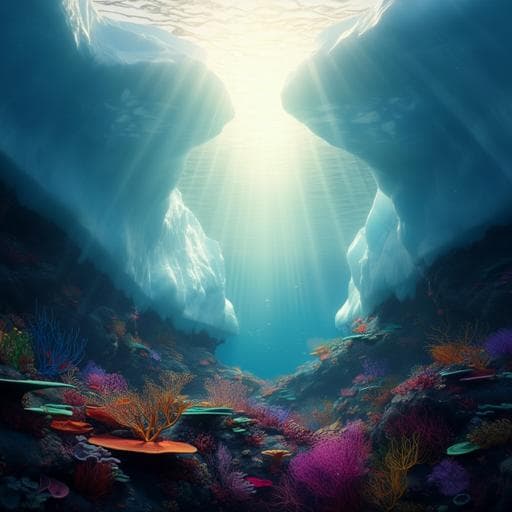
Earth Sciences
Arctic marine heatwaves forced by greenhouse gases and triggered by abrupt sea-ice melt
A. Barkhordarian, D. M. Nielsen, et al.
Explore the groundbreaking study by Armineh Barkhordarian, David M. Nielsen, Dirk Olonscheck, and Johanna Baehr, which reveals that the increasing intensity of Arctic marine heatwaves is largely driven by greenhouse gas emissions and significant sea-ice retreat. Discover how these factors are reshaping our oceans and what this means for our planet's future.
~3 min • Beginner • English
Introduction
The study investigates to what extent human-induced greenhouse gas (GHG) forcing is responsible for the emergence and characteristics of Arctic marine heatwaves (MHWs). Motivated by severe ecological and socioeconomic impacts of MHWs and the relative lack of focus on Arctic events, the authors frame two key questions: whether GHG forcing was necessary for recent Arctic MHWs and whether it is sufficient to predict their recurrence. The Arctic has warmed nearly four times faster than the globe with strong seasonality and concurrent sea-ice retreat. Notable post-2007 transformations include shifts toward thinner, more uniform first-year ice and record-low sea-ice extents. Prior event attribution has linked extreme sea-ice minima to anthropogenic and natural forcings, but a formal attribution of Arctic MHWs had been missing. This paper combines event attribution for extremes (daily scale) and detection/attribution of long-term SST trends (multi-decadal scale) to quantify the human fingerprint on Arctic marginal seas SST and MHWs.
Literature Review
The paper synthesizes prior evidence that Arctic sea-ice variability is primarily driven by atmospheric temperature fluctuations, with secondary roles for albedo, clouds, water vapor, winds, and poleward energy transport. Increases in GHGs drive Arctic land surface temperature trends, partially offset by aerosols. Historical analyses show regime shifts in sea-ice thickness and structure, and substantial declines in sea-ice extent. Extreme event attribution previously demonstrated that the 2012 sea-ice minimum magnitude required combined anthropogenic and natural forcings. Globally, definitions and frameworks for MHWs are established, and Arctic MHWs have been noted but understudied relative to other basins. The literature also relates Arctic sea-ice loss and SST changes to global-mean temperature, atmospheric CO2, and cumulative emissions, supporting the plausibility of detectable GHG signals in Arctic SSTs.
Methodology
Study region: Arctic marginal seas defined as 45°E–140°W and 68°N–80°N, excluding Barents and Norwegian seas; predominantly shallow mixed layers (~10–11 m in July–August) and covered by first-year ice. Data: NOAA daily OISSTv2.1 (DOISST) SST (0.25° resolution, Sept 1981–Feb 2022); NOAA/NSIDC passive microwave sea-ice concentration (SIC, 25 km); ERA5 reanalysis surface heat fluxes. Models: Large ensembles with single-forcing experiments from CESM1-LE (20 members), MPI-ESM-LR (30 members), CanESM5 (50 members). For extreme-event attribution, CESM1-LE provides paired ensembles with ALL forcing and with fixed GHG (LE-fixGHG) on daily SST; RCP8.5 after 2006. Marine heatwave detection: Using Hobday et al. definition via heatwaveR; MHW occurs when SST exceeds a seasonally varying 95th-percentile threshold (1983–2012 baseline) for ≥5 consecutive days (gaps <3 days) and is above mean summer temperature. Regions with SST standard deviation <0.25 °C are masked to avoid unreliable detection under heavy ice. For each MHW, duration, mean intensity (°C above threshold), and cumulative intensity (°C·days) are computed. Open-water period: Defined as time between last day with SIC >15% before annual minimum and first day with SIC >15% after the minimum; 5-day moving-average applied to SIC to reduce short-term noise. Cumulative solar heating: Daily absorbed solar heat flux into open water Frw = Fi(1−α)(1−C) with ocean albedo α=0.07; computed per grid cell daily (1982–2021) and summed annually to form anomalies relative to mean. SST–heat flux relationship: Regression of normalized SST (JAS) against net atmospheric surface heat flux Qnet (shortwave + longwave + turbulent SH+LH) to quantify explained variance. Detection and attribution of long-term SST trends: Uni-variate total least squares regression projects observed August SST trends (moving windows) onto model-simulated GHG-only response patterns from MPI-ESM-LR (30) and CanESM5 (50). Time-evolving internal variability estimated from ALL-forcing ensembles by subtracting the ensemble mean from each member at each time step. Detection is claimed when scaling factor confidence intervals exclude zero and are consistent with unity. Extreme event attribution: Based on causal counterfactual theory; compute probabilities of exceeding observed thresholds (intensity, duration, cumulative intensity) with ALL forcing and with fixed GHG. Derive probability of necessary causation (PN = 1 − Pfix/Pall) and probability of sufficient causation (PS = 1 − (1−Pfix)/(1−Pall)), with PN/PS set to zero if negative. Uncertainty estimated by bootstrap resampling. Additional model construction for isolated GHG effects in some analyses uses GHG_i = fixGHG_i − 2(fixGHG_em) + ALL_em. Uncertainty and robustness: Bootstrapped PN/PS curves; large ensembles sample internal variability (e.g., PDO, AO).
Key Findings
- Onset and characteristics of Arctic MHWs: Eleven MHWs detected from 2007–2021, mainly over Kara, Laptev, East Siberian, Chukchi, and Beaufort seas. Mean duration ~37 days; mean peak anomaly ~3 °C; mean intensity 2.2 °C; mean cumulative intensity 95 °C·days. - Notable events: 2007 MHW lasted 91 days with 3.4 °C max intensity and 188 °C·days; coincided with record-low September SIE of 4.28×10^6 km². 2012 MHW: 30 days, 2.1 °C, 50 °C·days; SIE 3.62×10^6 km² (22% below 1991–2020 mean). 2020 MHW: 103 days, 4 °C max intensity, 300 °C·days; SST up to 6 °C above climatology in Kara/Laptev; SIE 3.9×10^6 km² (19% below mean). - Variability explained by surface fluxes: 82% of JAS SST variability over marginal seas explained by net surface heat flux (Qnet); positive Qnet anomalies since 2006 with strong peaks in 2007 and 2020 indicate seasonal surface heat storage in summer drives SST anomalies. - Event attribution (probabilities): PN for intensity reaches 1.0 by ~1.5 °C; thus events with intensity >1.5 °C virtually certainly require GHG forcing. PN for 2020 intensity ~0.99 [0.98–1.0]. For cumulative intensity, PN reaches 1.0 by ~205 °C·days; e.g., 2007 event (188 °C·days) PN=0.93 [0.90–0.99]. For duration, 2012 event (30 days) PN=0.58 [0.57–0.78]. PS for intensity declines to ~0 for intensities >2.3 °C (such extremes are rare even with ALL forcing). For moderate intensity (~1 °C), PS≈0.66, indicating GHG forcing likely sufficient for recurrence. - Mechanisms: Persistent increase in annual absorbed solar heat (Frw) up to ~70% per decade (1996–2021), largest where sea-ice loss is greatest and open-water season lengthens (~40 days per decade). MHWs are primarily triggered by abrupt early-summer sea-ice retreat coincident with midsummer (June/July) maximum downward radiative fluxes; the June/July ice-melt rate increased from ~1.8×10^3 km²/day (1996) to ~2.5×10^4 km²/day (2021), a 38% increase over 25 years. The 2020 MHW exceeded 2012 in intensity due to earlier sea-ice loss aligning with peak July radiative input. Autumn (peak October) upward LW and turbulent fluxes increased by ~+5.6 W m⁻² per decade (1996–2021), with +15 W m⁻² anomalies during 2020, consistent with enhanced ocean heat release. - Long-term detection/attribution: August SST trends (1995–2020) show ~1.2 °C/decade warming over marginal seas (≈3 °C total 1996–2021). Scaling factors for 25-year trends ending in 2011 (MPI-ESM-LR) and 2009 (CanESM5) onward exclude zero and are consistent with unity at <5% risk, indicating a detectable GHG signal in observed SST trends. - Spatial context: Warming and extreme SST days (+>25 days per summer with >95th-percentile exceedance) intensified over eastern marginal seas; shallow mixed layers and first-year ice promote strong SST response to radiative forcing.
Discussion
The analyses demonstrate that greenhouse gas forcing is virtually certainly a necessary cause of recent extreme Arctic MHWs (e.g., 2007, 2012, 2020) in terms of intensity and, for the most extreme, duration and cumulative intensity. However, GHG forcing alone is generally not sufficient to guarantee extreme MHW occurrence; internal variability and seasonal timing of sea-ice retreat relative to atmospheric radiative peaks modulate event realization. Moderate-intensity events (0.5–1 °C) attain likely or higher PS values, implying increased recurrence under continued GHG forcing. Mechanistically, abrupt early-summer sea-ice retreat exposes open water during peak solar input, enhancing absorbed shortwave radiation, leading to rapid SST rise in shallow, stratified first-year-ice regions and fueling MHWs; excess heat is subsequently released to the atmosphere in autumn. The detection of a GHG signal in multi-decadal SST warming over the same regions provides a consistent underlying state change that elevates baseline temperatures upon which extremes occur, reinforcing attribution results and implying a trajectory toward more frequent and intense Arctic MHWs as emissions rise and first-year ice extent expands.
Conclusion
Arctic MHWs have entered a new regime since 2007, concentrated over shallow, first-year-ice-dominated marginal seas with strong summer stratification. About 82% of SST variability is explained by net atmospheric heat fluxes, and MHWs are primarily triggered by abrupt early-summer sea-ice retreat coincident with midsummer maximum downward radiative flux. Event attribution indicates that MHWs with intensity >1.5 °C are exceptionally unlikely without GHG forcing; recent extreme events (2007, 2020) virtually certainly required GHG forcing, which is necessary but not sufficient for such extremes. For moderate events (0.5–1 °C), GHG forcing is likely to very likely sufficient, implying persistent recurrence if emissions continue to increase. Long-term trend detection reveals a clear GHG fingerprint in August SST warming (~3 °C over 1996–2021) across the marginal seas. Together, these results suggest the Arctic will experience increasingly frequent and intense SST extremes, compounding climate impacts and accelerating sea-ice decline under continued GHG emissions.
Limitations
- Event attribution of daily MHW metrics relies on CESM1-LE, noted as the only comprehensive model with complementary historical single-forcing large ensembles providing daily SST; dependence on a single model for daily attribution may limit generalizability. - Arctic SST observations in ice-covered regions depend largely on proxy SSTs derived from satellite sea-ice concentration (blended into OISST), introducing observational uncertainties. - Regions with SST standard deviation <0.25 °C were masked because MHW detection there is less reliable due to high sea-ice concentration and low SST variability, limiting spatial coverage. - Surface fluxes and atmospheric inputs are from ERA5 reanalysis, which, while improved and widely used for the Arctic, still carry reanalysis uncertainties. - Detection/attribution of long-term trends uses model-simulated GHG-only responses and internal variability estimated from ALL-forcing ensembles; conclusions depend on the robustness of ensemble sampling of internal variability and model fidelity (e.g., equilibrium climate sensitivity differences between MPI-ESM-LR and CanESM5).
Related Publications
Explore these studies to deepen your understanding of the subject.







